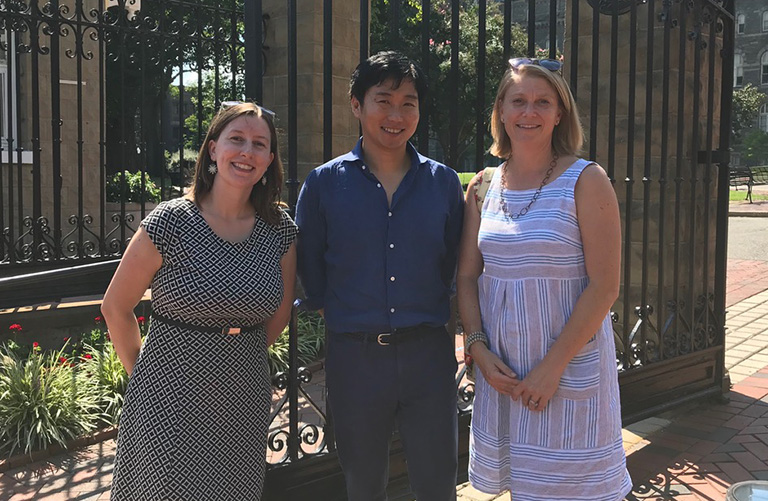Benton-Cohen Teaches Immigration History in Japan Residency
Professor Katherine Benton-Cohen (right) visited Japan last summer as part of an academic residency. Her host at Shuo University, Professor Yuki Oda (center), later visited Benton-Cohen and Ph.D. student Molly Thacker at Georgetown. (Photo courtesy Katherine Benton-Cohen)
December 18, 2018 — Georgetown College history professor Katherine Benton-Cohen has been studying the complex history of the U.S.-Mexico border for years. This past summer, she explored her work alongside students in Japan — where a land border is itself a foreign concept.
Benton-Cohen spent three weeks in Japan last summer as part of a residency sponsored by the Organization of American Historians, the Japanese Association for American Studies, and the Japan-U.S. Friendship Commission.
AN IMMIGRATION HISTORIAN
Through the program, two scholars of American history each year are selected to travel to Japan. This year’s delegation included Benton-Cohen and Prof. Bethel Saler of Haverford College — incidentally, a graduate school classmate of Benton-Cohen at the University of Wisconsin.
An Arizona native, Benton-Cohen has focused her academic career on the American West and the U.S.-Mexico border. After she arrived at Georgetown in 2007, she began focusing more specifically on the history of immigration policy.
Her most recent book, Inventing the Immigration Problem: The Dillingham Commission and its Legacy, published by Harvard University Press in May, provides a new perspective on the Dillingham Commission, a panel of experts who produced 41 volumes of reports from 1907 to 1911. Their conclusions have shaped and inspired immigration policies ever since.
“This project really drew me into thinking of myself as an immigration historian,” Benton-Cohen said.
WATER AND LAND BORDERS
Chuo University hosted Benton-Cohen during her three-week stay in Japan. She gave six talks on the history of immigration to the United States: two conference paper presentations, one graduate student seminar, and three undergraduate classes at Chuo and Doshisha University.
“We started by looking at the modern state of the U.S.-Mexico border, and unpacked how different the rhetoric around immigration was in the 19th century,” Benton-Cohen said. “We had some good discussions about Japan — being an island nation that is also an empire — and the difference between water and land borders.”
In addition to the undergraduate lectures, Benton-Cohen presented a paper at the JAAS annual conference in Kitakyushu and participated in a group discussion with graduate students at the University of Tokyo.
“The seminar was a lot of fun, because [Saler] and I got to talk about how we chose our topics, and how academia really works,” Benton-Cohen said.
FACULTY GRANTS
While she had been aware of the OAH/JAAS program for years, the stars had not aligned for Benton-Cohen to make the trip until 2018 — due in large part to the International Travel Grant and the Childcare Grant, which help defray travel costs for faculty members on academic trips.
“I had lobbied for this program for a long time, and then I got to be a recipient of it” Benton-Cohen said. “It allowed me to bring my family, and I never would have done it if I couldn’t bring my family.”
Benton-Cohen also credits her Department of History colleague Jordan Sand with exposing her to Asian-American history by inviting her to a 2015 working group funded by the Global Engagement International Collaborative Grant.
“My specialty was the American West and immigration history, and I had no formal research training in Asian-American history before that,” Benton-Cohen said. “The opening chapter of my newest book is about the agreement between the United States and Japan to ban Japanese laborers from the United States,” and on the basis of a draft he read, Sand invited her to join. “That working group was my entrée to the field.”
The trip had a meaningful influence on Benton-Cohen’s teaching.
“It exposed me to a side of the immigration story that’s really important, and that I hadn’t seen before,” she said. “I think I’ll even see my own teaching in a different way now.”
— Patrick Curran
